SRM-AP All News
ALL News
- Mr Aaditya Jain’s article featured in Brainz magazine June 15, 2022
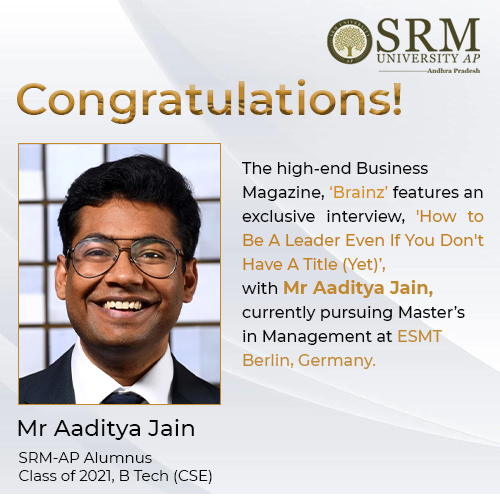
The leaders of tomorrow are defined by the clarity of thought in translating their vision into action. Their words reflect the undying spirit to make it big in life and brace up the world for unforeseen challenges in the times to come. Currently pursuing Master’s in Management at ESMT Berlin, Mr Aaditya Jain, the alumnus of Class of 2021, Computer Science and Engineering, is one such promising leader who is on an endeavour to gear up his personal and professional limits with a solid vision and impeccable work ethic. The high-end Business magazine of Europe, ‘Brainz’ has recently featured his article titled ‘How to Be A Leader Even If You Don’t Have A Title (Yet)’.
Brainz magazine is a global digital periodical that brings influential entrepreneurs, coaches, and business experts to share their knowledge and stories with the world. It features articles across various themes- exploring business innovations, leadership mindsets, aspirational lifestyles, and many more. The magazine aims to disperse inspiring content to augment the quality of life in all aspects. In an interview with Snježana “Ana” Billian, Aaditya shared the top four tips on how to show leadership at work, even if you don’t have a leadership title. As far as he is concerned, one must lead oneself before venturing out to lead others.
Aaditya pronounces the importance of self-awareness as it gives the opportunity to capitalize on one’s strengths and weaknesses to create as much value as possible in every situation. “One of the most powerful things I was told by one of my professors back during my undergrad is: We have all the resources within us. This statement inspired me to embark on a journey of self-discovery” he remarked. Aaditya is also aware of the huge benefit of the internet. Sharing one’s views and experiences online does not require a title. He regularly shares his experience at work and the lessons he learned on leadership online. This makes it easier for him to reach out to like-minded people and create a shared value.
“The need to mould oneself as a proactive communicator and concoct a support network at professional space is essential to ensure one’s career advancement”, says Aaditya. He believes, that asking out for help is a quality that must be encouraged. He further went on to divulge how moving to Germany and settling in was not an easy job. But according to him, the greatest challenge was how to make the most out of it. Success in the words of Aaditya is, “Living my values while continuously growing and inspiring human leadership at work”.
Here is the link to his article: https://www.brainzmagazine.com/post/how-to-be-a-leader-even-if-you-don-t-have-a-title-yet
Continue reading → - Hon’ble Minister Smt Vidadala Rajini inaugurates SRM AP blood donation camp June 14, 2022
Organised in association with the Indian Red Cross Society and STEP Swasakthi Guntur
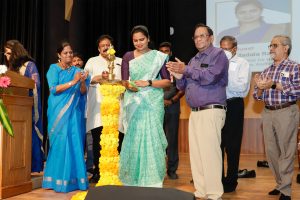 Around 140 students, faculty, non-teaching staff, and administrative members of SRM University-AP participated in the blood donation camp organised as a part of World Blood Donor Day. “You are really fortunate to be a part of this world-class university”, said Chief Guest Ms Rajini Vidadala, Hon’ble Minister for Health & Family Welfare-Government of Andhra Pradesh. She also acknowledged the CSR initiatives and commitment toward social causes by SRM Medical College and Research and the SRM group of institutions.
Around 140 students, faculty, non-teaching staff, and administrative members of SRM University-AP participated in the blood donation camp organised as a part of World Blood Donor Day. “You are really fortunate to be a part of this world-class university”, said Chief Guest Ms Rajini Vidadala, Hon’ble Minister for Health & Family Welfare-Government of Andhra Pradesh. She also acknowledged the CSR initiatives and commitment toward social causes by SRM Medical College and Research and the SRM group of institutions.In his presidential address, Pro-Vice-Chancellor Prof D Narayana Rao talked about the virtue of regular, voluntary, and unpaid blood donations. He further highlighted SRM University-AP’s achievements in building next-generation world-class scientists and innovators. He narrated the university’s commitment to creating a conducive research ecosystem.
World Blood Donor Day is observed on June 14 every year around the world to promote awareness about the need for safe transfusion and honour blood donors for their selfless act of saving lives. This year WHO observes the day on the theme “Donating blood is an act of solidarity. Join the effort and save lives”.
“This is the fourth time I am donating blood from SRM AP. I feel so proud and happy to be a part of this noble deed,”- says Ms Shalini Jayakumar, Assistant manager- Office of Examinations. She also encouraged women to come forward and donate blood without the fear of after-effects.
Certificates were distributed to the benevolent blood donors of SRM University-AP. Prof D Narayana Rao felicitated the Hon’ble Minister with a memento for her prolific contributions to society. The blood donation camp was organised in association with the Indian Red Cross Society (IRCS) and STEP Swasakthi Guntur. Addressing the gathering, Ramachandra Raju- Vice Chairman, IRCS Guntur, appreciated the non-teaching staff for being the leading light to students. NSS Coordinator of the university, Dr Lakshman Rao and Programme Officer Dr Pardha Saradhi Maram highlighted the role of blood donation in saving lives.
Dr R Premkumar-Registrar, Ms Suma N- Chief Finance and Accounts Officer (CFAO), Ms Revathi Balakrishnan- Student Affairs Assistant Director, Deans and Associate Deans of various schools, and Directors and Associate Directors of different departments were present at the meeting held at the university auditorium.
Continue reading → - Enhanced charge transport behaviour of protein-metal nanocluster hybrid June 14, 2022
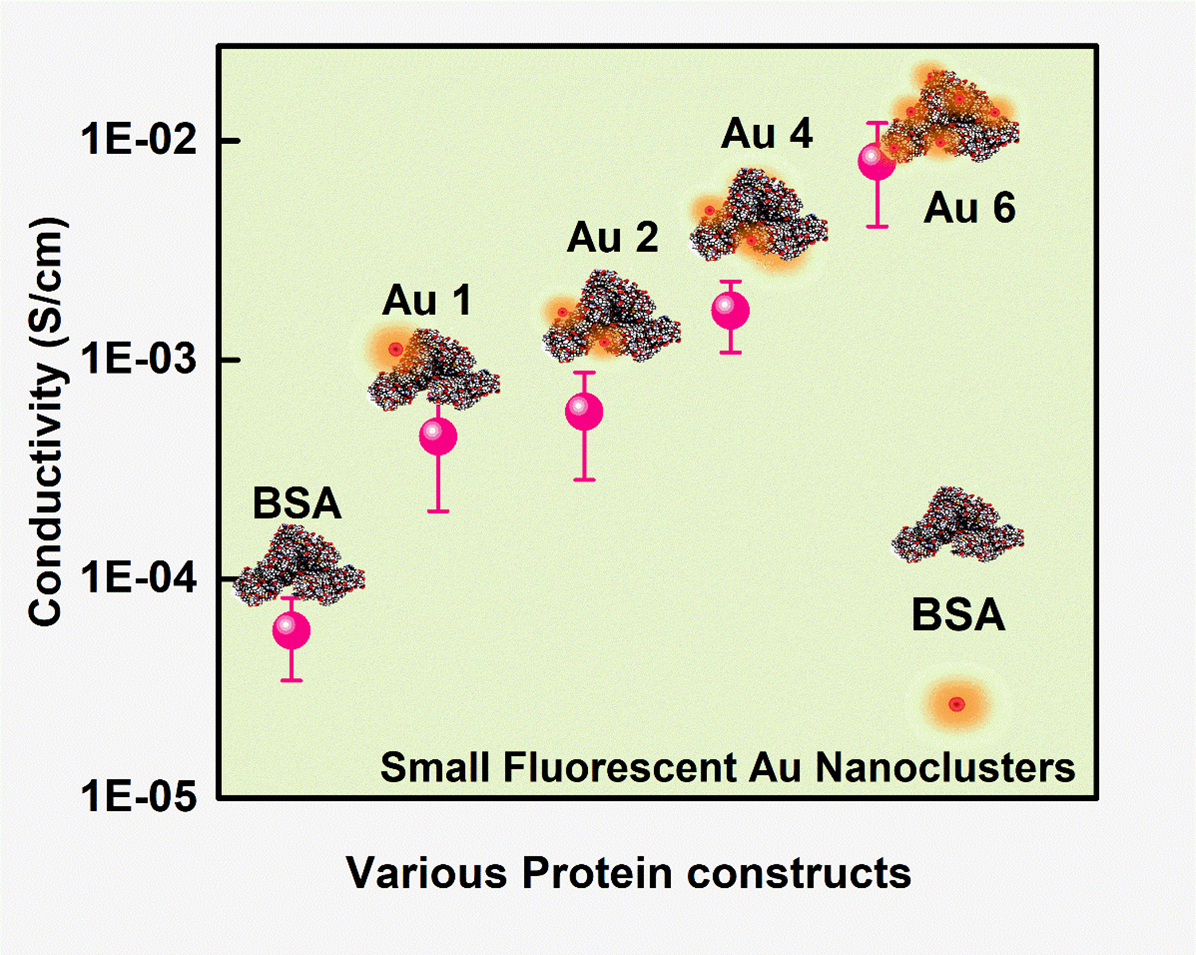
Proteins are the most vital life forms which maintain close coordination with almost living activities through their biological functions. Nevertheless, in most cases, proteins suffer from low charge (electron) transfer efficiency as they are mainly made of insulating organic molecules. The interdisciplinary research publication, of Dr Sabyasachi Mukhopadhyay and Dr Sabyasachi Chakrabortty from the Department of Physics & Department of Chemistry respectively, along with their PhD scholars: Ms Ashwini Nawade, Mr Kumar Babu Busi and Ms Kunchanapalli Ramya, envisions the molecular-level understanding of the charge transport behaviour of various protein-metal nanocluster hybrid.
The article titled ‘“Improved Charge Transport across Bovine Serum Albumin – Au Nanoclusters’ Hybrid Molecular Junction” was featured in the prestigious Q1 journal ACS Omega (IF: 3.512), published by the ‘American Chemical Society’. They successfully incorporated Gold Nanoclusters inside the protein backbone leading to an increase in their conductivity. This will provide new avenues for the rational design of bioelectronic devices with optimized features. The BSA-Au cluster has been a promising model for bioelectronic functionalities. With an increase in their current carrying capacity, they can be used for many more applications, especially as the interface between tissue and organ in biocompatible devices. The research team is also planning to work with various protein dopants to understand their charge transport mechanism. These studies will help in using the protein for various applications mainly in bioimplants or biosensors for drug testing and diagnostics purposes.
Abstract of the Research
Proteins, a highly complex substance, have been the essential element in the living organism where various applications are envisioned due to their biocompatible nature. Apart from protein’s biological functions, contemporary research mainly focuses on their evolving potential associated with nanoscale electronics. Here, we report one type of chemical doping process in model protein molecules (BSA) to modulate its electrical conductivity by incorporating metal (Gold) nanoclusters on the surface or within it. The as-synthesized Au NCs incorporated inside the BSA (Au 1 to Au 6) were optically well characterized with UV-Vis, time-resolved photoluminescence (TRPL), X-ray photon spectroscopy, and high-resolution transmission electron microscopy techniques. The PL quantum yield for Au 1 is 6.8% whereas Au 6 is 0.03%. In addition, the electrical measurements showed ~10-fold enhancement of conductivity in Au 6 where maximum loading of Au NCs was predicted inside the protein matrix. We observed a dynamic behaviour in the electrical conduction of such protein-nanocluster films, which could have real-time applications in preparing biocompatible electronic devices.
Continue reading → - Recovery of nutrients from wastewater June 14, 2022
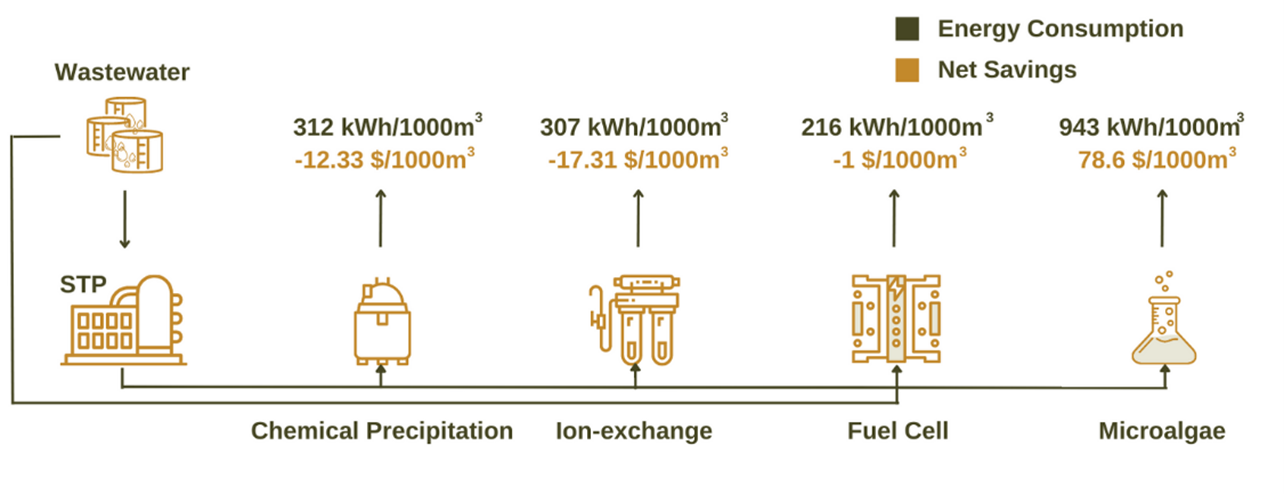
Water pollution continues to be one of the serious concerns facing the country. The ensuing scenario of eutrophication and harmful algal blooms has exacerbated the menace. This demands wholescale water management techniques to segregate the pollutants, retrieve useful nutrients, and treat the water effectively for sustainable use. Dr Karthik Rajendran and his PhD scholar, Mr Sarath Chandra, from the Department of Environment Science have published a paper discussing various nutrient recovery methods and their consequential outcomes. The research was done in collaboration with Dr Deepak Kumar from SUNY College of Environmental Science and Forestry, Syracuse, NY and Dr Richen Lin from Southeast University, Nanjing, China.
The article titled, “Nutrient recovery from wastewater in India: A perspective from mass and energy balance for a sustainable circular economy” was published in Bioresource Technology Reports (Q1 Journal), having an Impact Factor of 4.41. Their research investigates the possibilities of recovering Nitrogen (N) and Phosphorous (P) from wastewater in terms of technology, energy, and economic point of view. Excessive presence of Nitrogen and Phosphorous can result in eutrophication and algal blooming. These nutrients also pose a harmful threat to infrastructure. Nutrient recovery can mitigate these challenges and improve the quality of water.
Phosphorus is one of the limited resources available on earth and a key ingredient in fertilizer production. The recovery process also helps in transforming wastewater into resource pools that can efficiently churn out valuables that hold the key to a sustainable future. This will help reduce the imports of fertilizers and bring down the emissions to half in producing fertilizers. Their findings will also pave the way for making necessary policies to reduce water pollution and recover nutrients. As two-thirds of wastewater remains uncollected, they claim that effective treatment and water management practices can save around 800 crores per annum. Their future research plan also includes the experimental analysis of the nutrient recovery system.
Abstract of the Research
Wastewater (WW) is a potential source to recover N, and P, whereas, in India, it is scarcely explored. In this work, four different nutrient recovery methods were compared from a mass- and energy-balance perspective to understand the overall process flow. From 1000-m3 WW, chemical precipitation yielded 33.8 kg struvite, while micro-algae resulted in 299.1 kg (dry powder). Energy consumption was lowest for the fuel cells at 216.2 kWh/1000 m3, while microalgae used the highest energy at 943.3 kWh/1000 m3. Nonetheless, the cost-saving analysis showed that microalgae (78.6$/1000 m3) as a nutrient recovery choice, had higher savings than any other methods compared. For a country like India, where two-thirds of urban wastewater is untreated, wastewater-biorefinery options such as nutrient recovery hold the key to a sustainable circular economy.
- Comparing organic food preferences of American and Indian consumers June 13, 2022
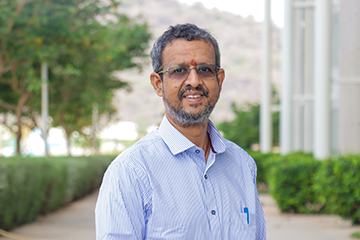
A paper titled “Organic food preferences: A comparison of American and Indian consumers” has been published by Prof Bharadhwaj Sivakumaran, Dean- SEAMS, SRM University-AP, Kirubaharan Boobalan (SSN College of Engineering), and Margaret Susairaj (Great Lakes Institute of Management, Chennai) in the journal Food Quality and Preference having an Impact Factor of 5.6.
This research tests a nomological model predicting organic food attitudes and purchase intentions in USA and India. Data were collected from India (n = 687) and the USA (n = 632) using Amazon M Turk and were analyzed using structural equation modelling and multi-group moderation technique. Results revealed that over and above attitude, subjective norm and perceived behavioural control, response efficacy and self-expressive benefits significantly affect consumers’ attitudes and purchase intentions toward organic food among American and Indian consumers. Findings reveal that response efficacy and attitude matter more in the USA while subjective norms and self-expressive benefits exert a greater influence in India. Therefore, marketers may reinforce belief-related elements while selling organic food products in the USA and societal-related elements while selling in India. Theoretically, this work adds to the Theory of Planned Behavior by adding self-expressive benefits and develops a common model for organic food across samples in USA and India.
Continue reading → - Food safety applications of surface-enhanced Raman Spectroscopy June 10, 2022
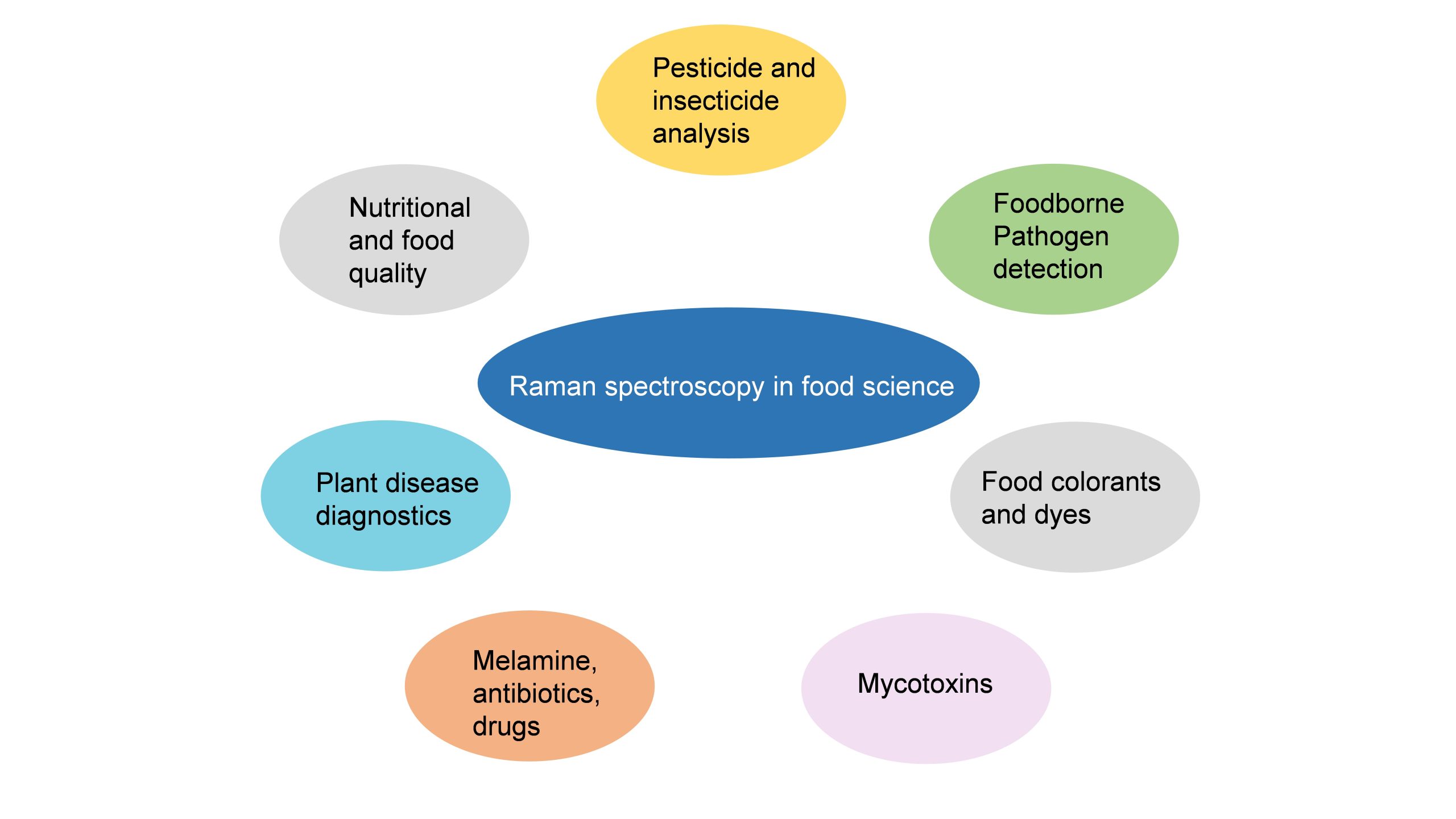
Surface-enhanced Raman Spectroscopy (SERS) is a nuanced chemical technique that amplifies the Raman scattering of molecules by utilising plasmonic nanostructured materials. SERS operates as a powerful detection tool that allows for the structural fingerprinting of a molecule. The ultra-high sensitivity and selectivity of the process offer it a vast array of applications in surface and interface chemistry, nanotechnology, biology, biomedicine, food science, environmental analysis and other areas.
Dr J P Raja Pandiyan and his PhD scholar, Ms Arunima Jinachandran from the Department of Chemistry have been keenly involved in exploring the possibilities of SERS technology in food science and other fields. The safety and quality concerns related to food were the primary reasons that impelled them to step into this domain. Their article “Surface-enhanced Raman spectroscopy for food quality and safety monitoring” was published in the book Nanotechnology Applications for Food Safety and Quality Monitoring, published by Elsevier. The article was published in collaboration with Dr Selvaraju Kanagarajan from the Swedish University of Agricultural Sciences.
Continue reading →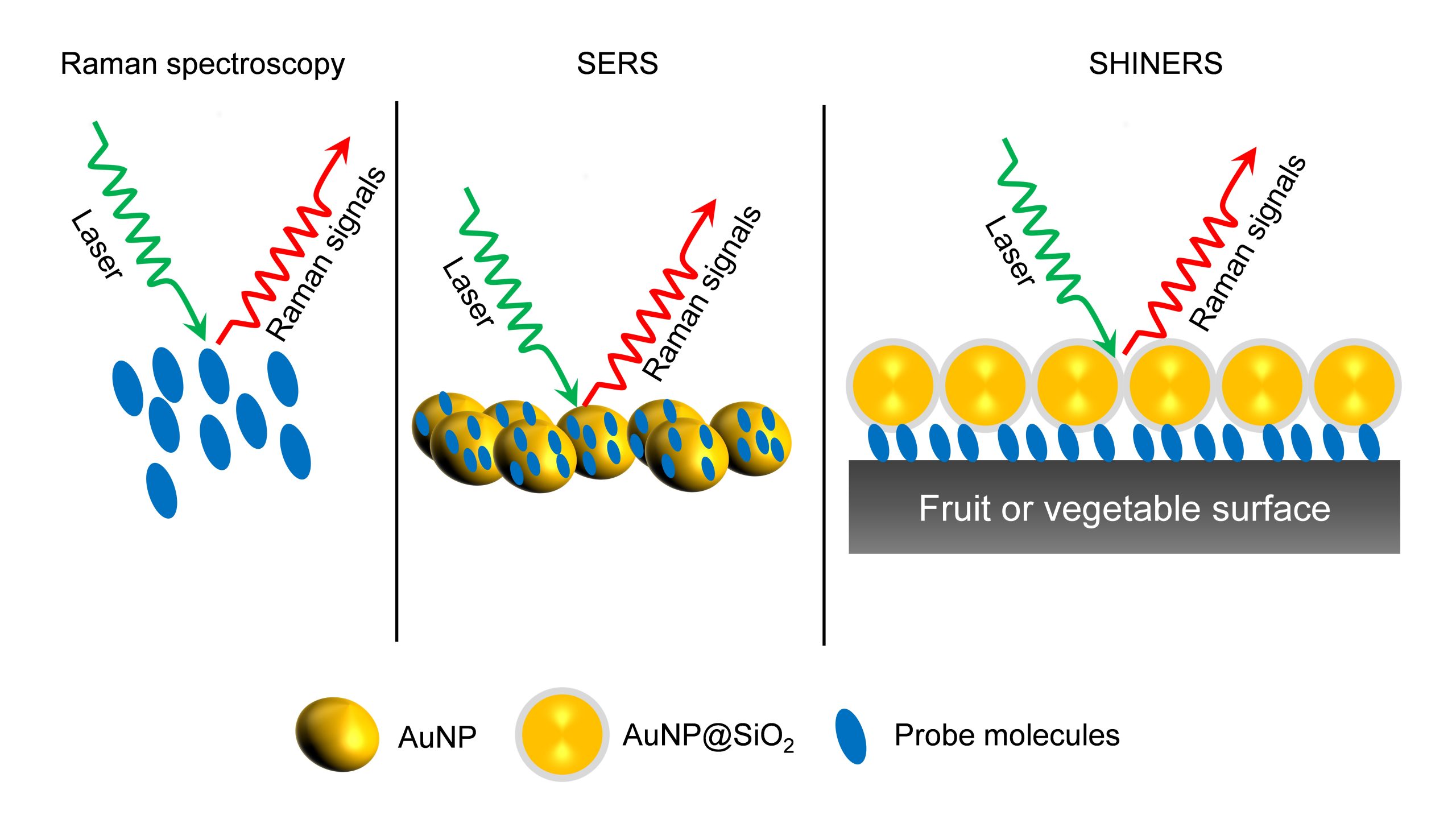 As an analytical technique, SERS possesses several advantages such as non-destructive, sensitive, and selective. In the chapter, the necessity, and applications of SERS in food science are elaborately discussed. They have also discussed all the possible food contaminants and how to identify them using SERS to ensure food quality. This book will serve as an enlightening read to research groups who are working on Raman, surface-enhanced Raman spectroscopy, analytical chemistry, and food quality analysis.
As an analytical technique, SERS possesses several advantages such as non-destructive, sensitive, and selective. In the chapter, the necessity, and applications of SERS in food science are elaborately discussed. They have also discussed all the possible food contaminants and how to identify them using SERS to ensure food quality. This book will serve as an enlightening read to research groups who are working on Raman, surface-enhanced Raman spectroscopy, analytical chemistry, and food quality analysis. - The pertinence of human activity recognition systems in the present era June 9, 2022
In recent years, human activity recognition has gained significant attention inside the scientific community. The enhanced spotlight is on the ground of its direct application in multiple domains. The latest research at the Department of Computer Science validates this assumption. Assistant Professor Dr V M Manikandan, and the 4th year B Tech Student Chaitanya Krishna Pasula have published a chapter titled An analysis of human activity recognition systems and their importance in the current era in the book Computational Intelligence Based Solutions for Vision Systems. The book is published by IOP Publishing Ltd.
Explanation of the chapter
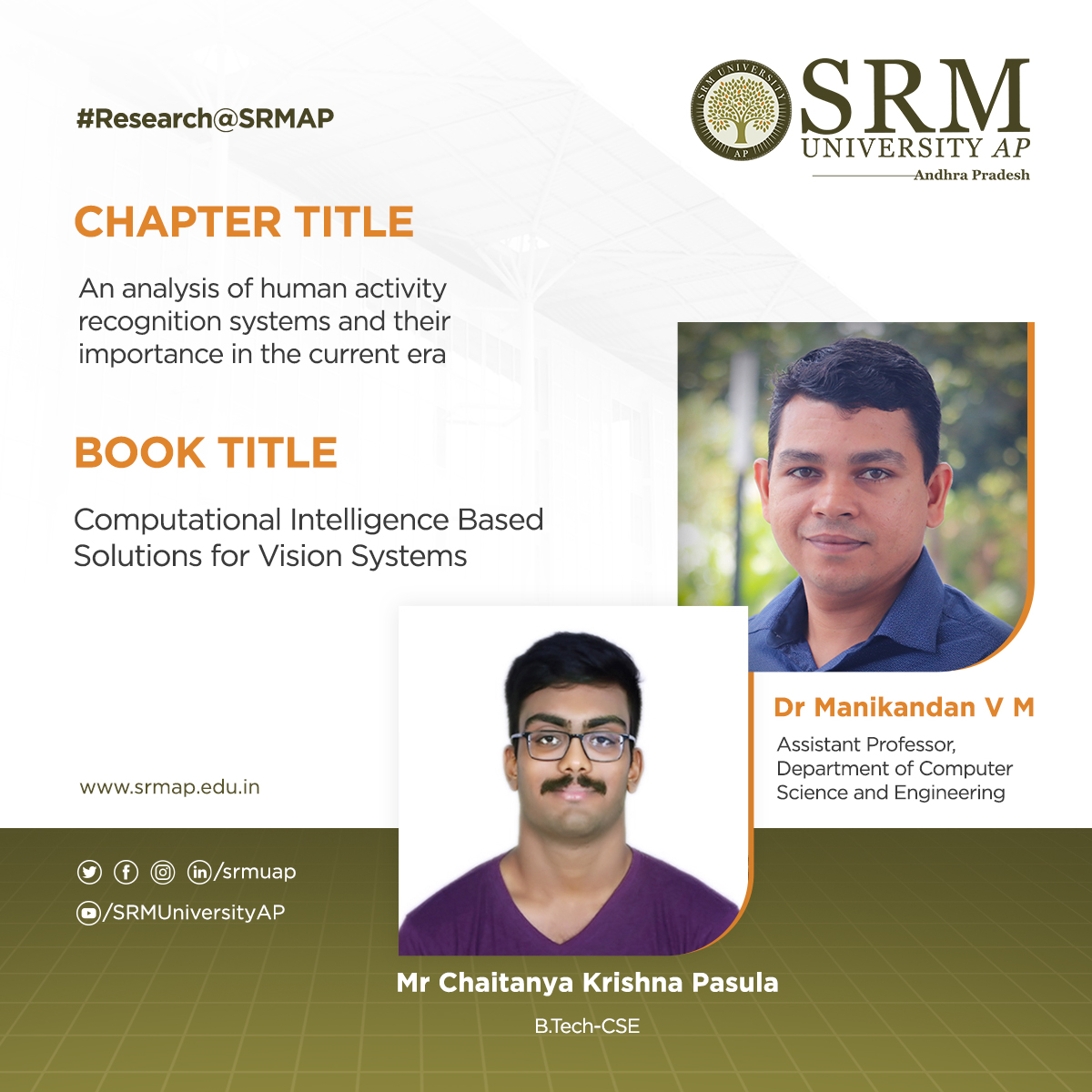 Human activity recognition is one of the most interesting and active research areas in computer vision. More research efforts are being put towards automatically identifying and analysing human activities due to their emerging importance in everyday applications. It serves applications in various areas like security video surveillance, smart homes, healthcare, human-computer interaction, virtual reality, robotics, and digital entertainment. Numerous papers have been published in the domain of human activity recognition. This book chapter discusses the various applications of human activity recognition, different methods available for automatic activity detection from videos, and the advantages of the human activity recognition system. It also describes the challenges in designing and implementing human activity detection schemes. Researchers further explain the publicly available datasets used for training and evaluating the systems for human activity recognition. The efficiency parameters used to evaluate the human activity recognition systems are also briefed in this chapter. The chapter is concluded by comparing the methodologies and speculating the possibilities of future research in this field.
Human activity recognition is one of the most interesting and active research areas in computer vision. More research efforts are being put towards automatically identifying and analysing human activities due to their emerging importance in everyday applications. It serves applications in various areas like security video surveillance, smart homes, healthcare, human-computer interaction, virtual reality, robotics, and digital entertainment. Numerous papers have been published in the domain of human activity recognition. This book chapter discusses the various applications of human activity recognition, different methods available for automatic activity detection from videos, and the advantages of the human activity recognition system. It also describes the challenges in designing and implementing human activity detection schemes. Researchers further explain the publicly available datasets used for training and evaluating the systems for human activity recognition. The efficiency parameters used to evaluate the human activity recognition systems are also briefed in this chapter. The chapter is concluded by comparing the methodologies and speculating the possibilities of future research in this field.In the future, the researchers are planning to design and implement an activity recognition system to identify abnormal activities in public places for safety purposes. This book chapter will be a helpful reference for UG/PG/Ph.D students who aspire to research in the domain of activity detection from video.
Continue reading → - An oil stove burning the waste oil: Innovation of the month June 9, 2022
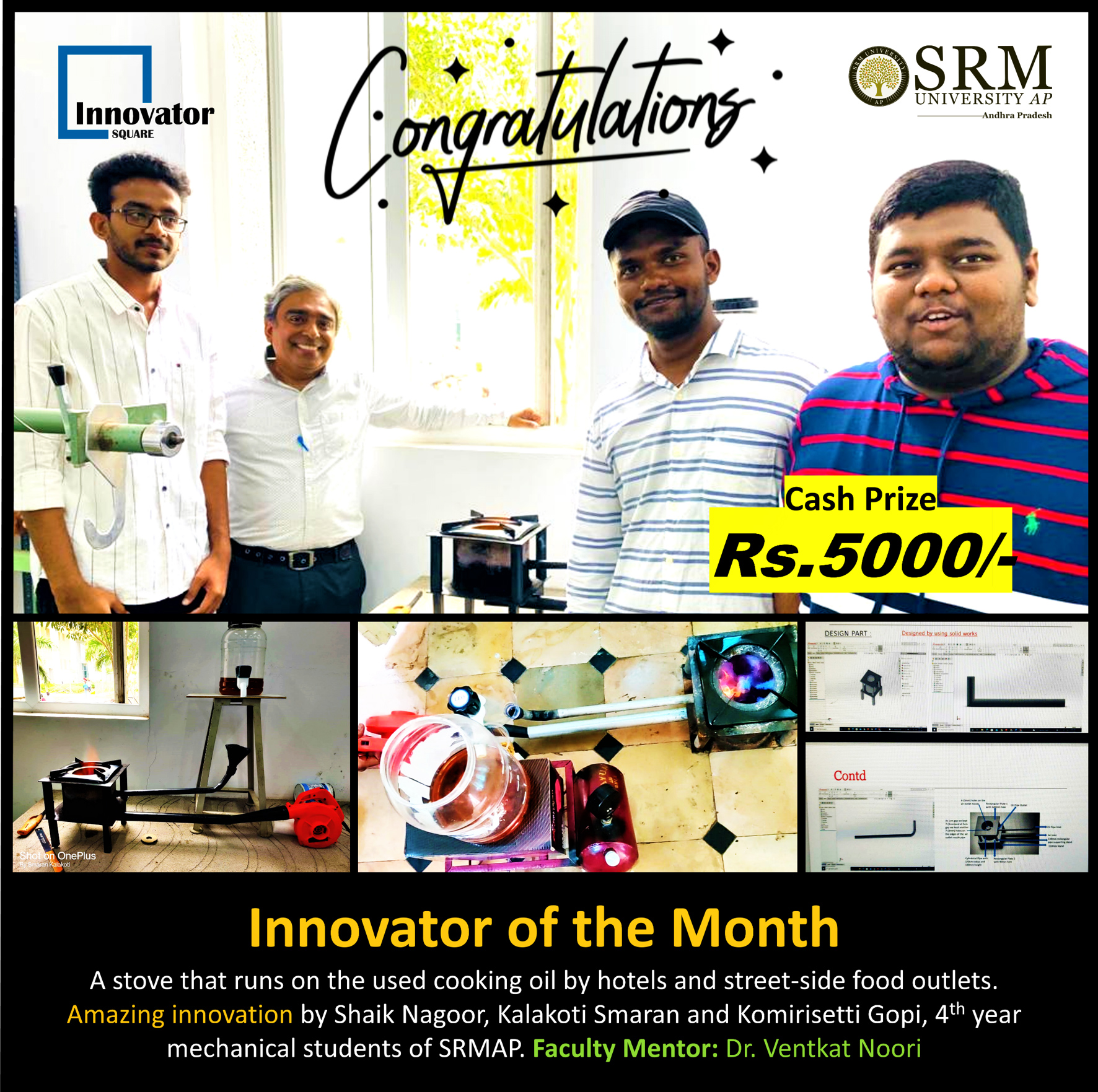
Innovation is seeing what everybody has seen and thinking what nobody has thought.
-Dr Albert Szent-Gyorgyi
The uncompromising vision to mould the students to be the leaders of tomorrow and to gear them up to think beyond the possible has been the propelling factor that drives each student of SRM University-AP to tread the unexplored paths and embrace the unseen challenges. They come out as transformed individuals, outgrown with enriching experiences, capable of introducing new changes into the world. Students are offered ample space and time to ideate, innovate, and build themselves into coming-of-age professionals.
Innovator Square is one such platform set up by the Entrepreneurship-cell to nurture innovative ideas and thoughts having the potential to be converted into a meaningful product or service. Each month, it brings out young talents who have expanded their limits to fashion out an unforeseen solution to the mundane troubles of society. The title winners of the ‘Innovator of the Month’ contest this time, are, Shaik Nagoor, Kalakoti Smaran, and Komirisetti Gopi, from the Department of Mechanical Engineering. They have designed a special stove that runs on used cooking oil.
Introducing innovations out of bits and pieces of the commonest of things adds value to our everyday lives. These budding masterminds deserve acknowledgement for their incredible solution to utilise the leftover oil. Cooking oil is a daily essential abundantly used in food processing industry, such as restaurants and fast food, as well as in households. Reusing the oil is found to have harmful effects as it contains carcinogenic substances, that may lead to cancer or other chronic health disorders. Hence the common practice followed is to dump it in open soil. However, this will affect soil fertility and a myriad of environmental concerns.
Their motive to offer a sustainable solution to this menace is what prompted them to devise a user-friendly stove that will consume the used cooking oil. This will also serve as a better alternative to LPG, saving up to 50% of the expenditure. The students expressed their happiness in having made their tiny share of contribution for the well-being of their society. They also thanked their faculty and the university for extending unswerving support to complete this project. “We can never thank enough Dr Venkata Nori sir for guiding and supporting us from the beginning of our project, he helped us achieve this innovation, we are also thankful to Mr Udayan Bakshi sir for helping us to build a start-up”, they remarked.
Continue reading → - Recasting high-entropy alloys for enhanced performance June 9, 2022
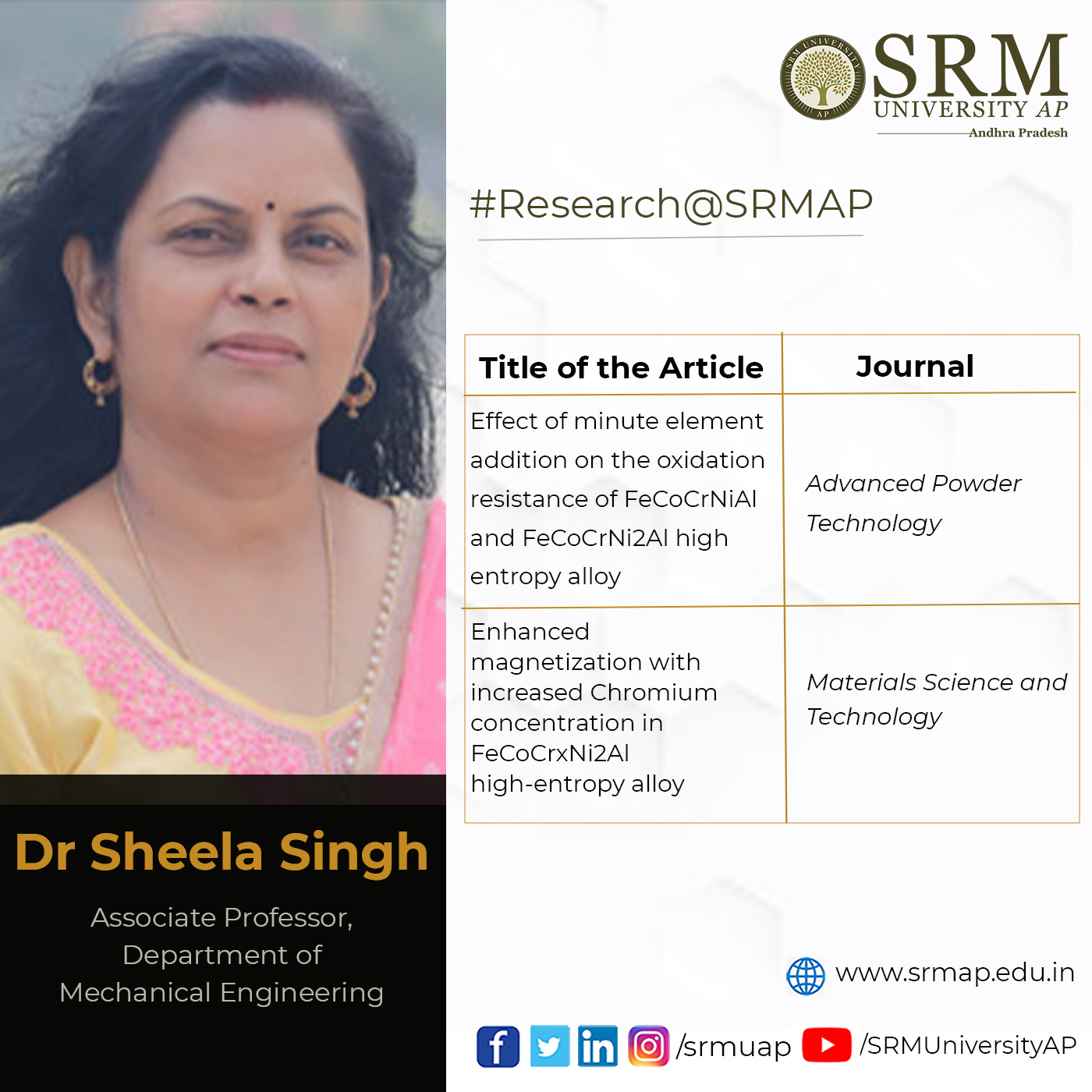
High-entropy alloys (HEAs) are gaining research significance in recent times as they propose novel alloy designs and concepts demonstrating better performance. HEAs constitute multiple principal elements in varying concentrations and combinations to produce new materials with excellent physical properties and superior performance at extreme temperature conditions. Recent studies have brought out a few high-entropy alloys possessing exceptional properties, even capable of challenging the existing theories and models for conventional alloys. However only very little has been explored within this multidimensional space leaving limitless possibilities to be explored and materialized.
Dr Sheela Singh, from the Department of Mechanical Engineering, has been conducting rigorous research in this domain and she has published research articles proposing novel ideas to tweak the properties of HEAs. In one of the articles co-authored by Dr Sheela, “Effect of minute element addition on the oxidation resistance of FeCoCrNiAl and FeCoCrNi2Al high entropy alloy”, published in the journal Advanced Powder Technology, she investigates the effect of Ti0.1 and Ti0.1Si0.1 addition on the high-temperature isothermal oxidation behaviour of dense FeCoCrNiAl and FeCoCrNi2Al high entropy alloys.
Mechanical properties such as hardness & young’s modulus, thermal properties such as melting temperature, specific heat capacity and coefficient of thermal expansion (CTE) were investigated by Nano hardness tester (NHT), differential scanning calorimetry (DSC) and dilatometer, respectively. The phases present in the HEAs produced by hot vacuum pressing and after isothermal oxidation were characterized by X-ray diffraction, Scanning Electron Microscopy and Raman Spectroscopy.
The weight gain recorded after isothermal oxidation for 5,25,50 and 100 hours at 1050°C was found to be parabolic in nature. X-ray diffraction analysis (XRD), as well as Raman spectroscopy analysis of HEA’s oxidized at 1050°C for 100 hours, shows the formation of the Al2O3 phase. A homogeneous thin oxide scale without any discontinuity was observed throughout the cross-section. It has been confirmed that Ti & Si addition in minute amount (0.1 at. % each) improves the mechanical properties and oxidation resistance as well as reduces the waviness of the oxide scale.
Another article co-published by her, “Enhanced Magnetization with Increased Chromium Concentration in FeCoCrxNi2Al High-Entropy Alloy”, in Materials and Science Technology, reports the effect of increasing the concentration of antiferromagnetic element Cr in FeCoCrxNi2Al (x = 0.5, 1.5) High Entropy Alloy (HEA) on their magnetic properties. It was found that the structure and composition of different phases, and the likely degree of spinodal decomposition in the Cr-Fe rich BCC phase significantly affects the magnetic properties.
Interestingly, the sample with Cr concentration x=1.5 showed two times larger saturation magnetization as compared to x=0.5. Furthermore, the magnetization versus temperature response shows a multi-phase character and exhibits distinct behaviour in low temperature and high-temperature regimes in both samples. The obtained soft ferromagnetic behaviour of these HEAs is crucial for the development of a new class of HEA for various applications.
The considerable structural and functional potential, as well as the richness of design, make HEAs promising candidates for new applications prompting further studies in the field. There remains a vast compositional space that is yet to be discovered. New studies have to be initiated finding out effective ways to recognise regions within this space where high-entropy alloys with potentially interesting properties may be lurking. Dr Sheela’s research is a right step in this direction to pave the way for fruitful developments in the future.
Continue reading → - Ameliorated Follow the Leader: Algorithm and Application to Truss Design Problem June 9, 2022
Q1 journal publications of our faculty members always bring honour to SRM University-AP. Dr Priyanka Singh, Assistant Professor from the Department of Computer Science and Engineering has published a paper titled “Ameliorated Follow the Leader: Algorithm and Application to Truss Design Problem” in the journal Structures (Q1 journal) having an impact factor of 2.983.
Abstract
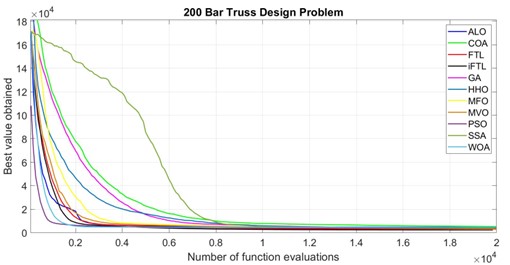 In the real world, resources, time, and money are always limited, necessitating the need for well-balanced algorithms. According to the “No-free-lunch” theorem, no single algorithm exists that works well in all applications. Hence, an optimisation algorithm with improved performance is always needed. The paper presents an improved follow the leader (iFTL) algorithm that imitates the behavioural movement of a sheep within the flock. The algorithm has been utilised to solve eight complex 10, 37, 52, 72, 120, 200, 224, and 942 bar truss design problems.
In the real world, resources, time, and money are always limited, necessitating the need for well-balanced algorithms. According to the “No-free-lunch” theorem, no single algorithm exists that works well in all applications. Hence, an optimisation algorithm with improved performance is always needed. The paper presents an improved follow the leader (iFTL) algorithm that imitates the behavioural movement of a sheep within the flock. The algorithm has been utilised to solve eight complex 10, 37, 52, 72, 120, 200, 224, and 942 bar truss design problems.Practical implications
The algorithm can be utilised to solve several structural and mechanical design problems such as bride design, antenna design, welded beam design, speed reducer, and many more. The algorithm is well suited for all types of real-life engineering problems where optimisation is required, from travel cost optimisation to optimisation of resources in the organisation under the given constraints and objective function.
Collaborators
1. Rahul Kottath (Computer Vision Engineer, Digital Tower, Bentley Systems India Private Limited, Pune, India)
2. Ghanshyam G. Tejani (Assistant Professor, Department of Mechanical Engineering, School of Technology, GSFC University, Vadodara, Gujarat, India)Future Research Plan
Currently, Dr Priyanka is exploring new engineering applications where optimisation techniques can be used. She is working on optimisation methods that can be utilised to classify microarray data, energy optimisation, and mechanical and structural design problems. In future, she plans to propose her work to the industrial level for the greater good and better solutions.
Continue reading →

